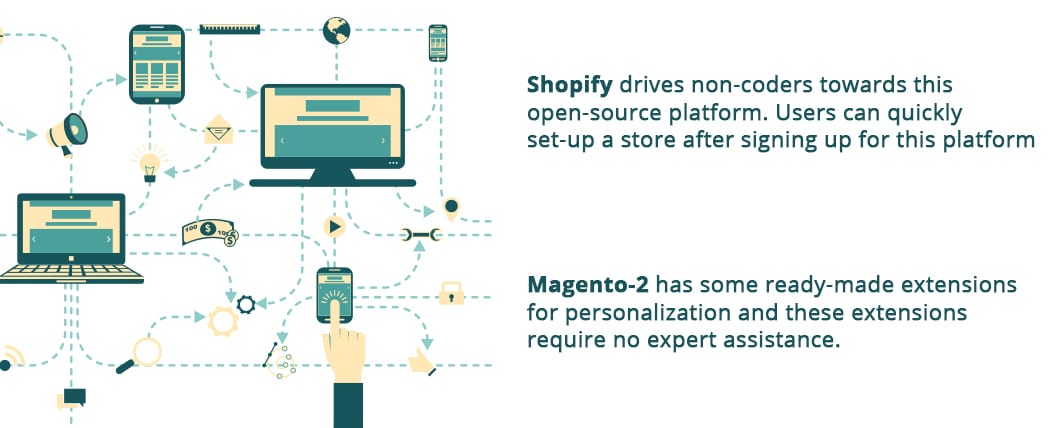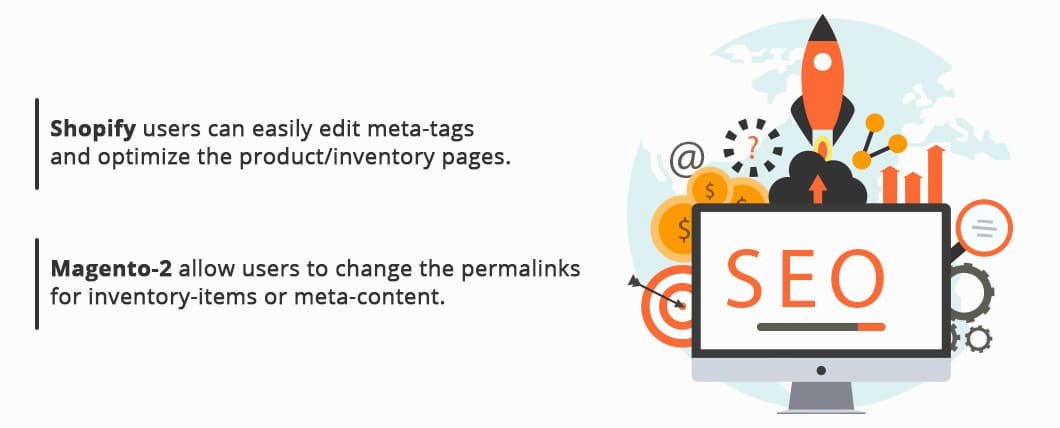Magento 2 Vs Shopify – Which One is Suitable for Your Online Store?
Application that runs an eCommerce store is responsible for the success or failure of an online business. It is therefore essential to carefully select an e-commerce platform for creating, maintaining and managing the online store. Small businesses owners need to be more careful about this fact as they have restricted budget and resources. Shopify and Magento-2 is two most popular e-commerce solutions, and many users have difficulty selecting the suitable platform amidst them. An overview of their differences may simplify the process of selection, as these platforms differ from one another in their basic structure, functionalities, capabilities and payment options.
Compared Popularity

A recent research conducted on the popularity of these two platforms shows that approximately 240,000 online domains have Shopify registration and 160,000 websites have a Magento registration. These numbers attest to the popularity of these open-source e-commerce solutions; however, deep research on this subject reveals more. Small online businesses usually prefer Shopify to Magento-2 due to its user-friendly features. Its marketed features are more attractive to new and inexperienced owners of an online store. Magento-2 with its scalable features is important for the future growth of an online business. However, it is usually the choice of medium or large businesses, as they look forward to future growth with stable commercial foothold.
Compared Capabilities

Shopify welcomes both the experienced and inexperienced users; therefore, it does not include a steep learning curve. It allows users to select different professionally designed themes capable of making a variety of adjustments, and users love this drag-and-drop feature. However, it does not give users a complete control over the designs or functions of online stores. In comparison, Magento–2 comes with many flexible features. It gives users complete freedom over how the online stores interact with current and potential customers. Using Magento-2, the users can alter the functionality and appearance of the online stores in entirety. Users may need a web-developer’s assistance regularly while handling the features of Magento-2 platform; therefore, it requires some basic experience.
Branding and Design Facilities

Uniqueness plays a vital role at the success of an online store, as it helps customers separate one store from another. The design of an online store is an important part of distinctive branding. Both Magento-2 and Shopify brings exclusive and responsive themes for use. These responsive themes are extremely important in today’s market, as these themes can function on different screen sizes. For instance, the proprietary themes from Shopify do not allow users to customize their site but they change the colors and font. This type of limitation may impair the users’ ability to customize the store’s design and limit their choice for a personalized branding. The updated version of Magento-2 has a drag-and-drop visual editing function allowing the coders/non-coders to create uniquely beautiful sites in a jiffy.
Users’ Experience

The ease of experience with Shopify drives non-coders towards this open-source platform. Users can quickly set-up a store after signing up for this platform, which includes some website-building tools to personalize a store’s features with the help of in-house experts. On the other hand, Magento-2 has some ready-made extensions for personalization and these extensions require no expert assistance. This updated version of Magento even resolves the troubling issues of Magento-1 and offers a sublime experience to the users. The admin module of Magento-2 has simpler functions in comparison to Shopify which makes it easier for users to manage payment processors, access advanced reports, market products, sort customers and perform other essential tasks.
Speed Optimization and Performance

Success of all eCommerce stores depends on their performance and speed, as the users hate to wait for long when accessing an online store. They want to browse through the products, make a selection and complete the purchase, quickly. Therefore, it is essential for the stores to load faster to keep the users from moving towards a competitive site. Users need not worry about websites’ and server performance with Shopify, as it is a hosted solution. On the other hand, the Magento-2 has two different options for users. The online stores using Magento Commerce-Cloud service can stay live always; however, the responsibility of hosting remains on the store’s owner with the open-source variant.
SEO Capabilities

Users can easily edit meta-tags and optimize the product/inventory pages in SEO-friendly format using basic sets of SEO options available through Shopify. However, they cannot perform deeper configurations. The open-source platform Magento-2 allow users to change the permalinks for inventory-items or meta-content and make a complete use of canonical tags/ no-follow links/redirects.
Costs Involved

The subscription based model of Shopify makes it possible for users to retain a free-trial before selecting the paid version. It is also possible for users to choose from various paid services depending upon their necessities. The Magento-2 may provide a wider platform; however, it is impossible to learn about the exact expense until the users talk to the partners. There is no fixed-price service at the Magento and everything is personalized as per the users’ necessities.
Depending on your unique business needs, you can opt for either of them to improve and boost your revenues and profits.